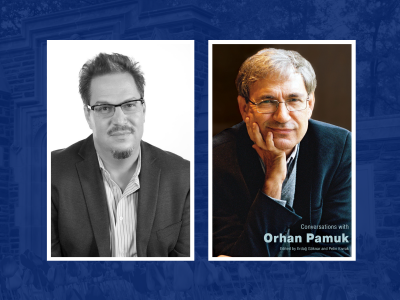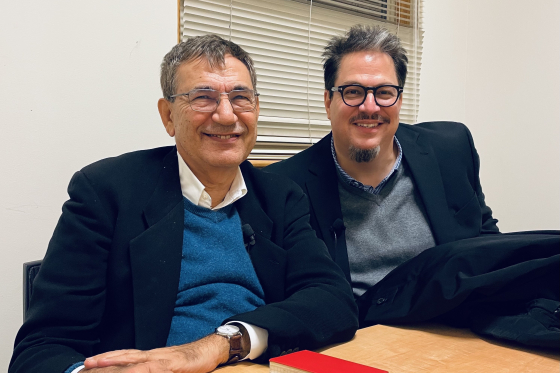Margo Lakin, Trinity Communications

Erdağ Göknar is well-versed when it comes to Turkish novelist and academic Orhan Pamuk. He’s worked with him for decades, written a book that serves as the first critical study of his novels and translated the Nobel laureate’s work.
“As a Fulbright fellow in the mid 1990s, I first heard Orhan Pamuk give a talk on Turkish modernism at a bookstore in Istanbul,” Göknar recalls. “I was studying literature but hadn’t fully realized the ways in which it intersects with and informs Turkish identity-formation, history and politics.”
The associate professor with the Department of Asian and Middle Eastern Studies explains that Pamuk’s work traces social and cultural changes in the fraught encounter between European modernity and Ottoman or Turkish Muslim society.
“Pamuk is known for formal innovations that incorporate traditional, realist, modern, postmodern and postcolonial forms — and the works contain self-referential and autobiographical flourishes that shed light on present-day Turkish politics,” he says.
Göknar is co-editor of the recently published book “Conversations with Orhan Pamuk” that contains over 30 interviews spanning 40 years.
“The book is a compilation, from Pamuk’s earliest interviews with the Turkish press after the publication of his first novel ‘Cevdet Bey and Sons’ in 1982 to interviews about his most recent work ‘Nights of Plague,’” he shares. “The conversations trace social change as reflected in literature from an era dominated by secularism to one of Islamist politics.”
Göknar sees the book as a work of cultural translation that provides the historical and political contexts of Orhan Pamuk’s work through interviews. Many have never appeared in English, and two were recorded during Pamuk’s visits to the Duke campus in 2015 and 2022.
We sat down with Göknar to learn more about the subject of his latest publication. This interview has been lightly edited for length and clarity.
What is it about Orhan Pamuk’s work that speaks to you?
Pamuk’s settings, characters and representations of material culture have opened new dimensions of understanding for me. His work is Janus-faced and delves into the history and legacies of the Ottoman Empire while illuminating contemporary Turkish politics.
Recently, he has begun publishing photography collections, notebook sketches and drawings, working with curation as a form of cultural production. Pamuk opened a museum in Istanbul based on his novel “The Museum of Innocence” and explores the way objects and collective memory intersect. These innovative approaches to representing Turkish culture reveal subtleties about everyday life in Turkey.
Are there challenges that are naturally inherent in cultural translation projects such as this one?
Cultural translation provides the reader with a legible context to understand the nuances and tropes in literature. An interview situates the work of art into intellectual history, comparative history or world literature. In short, it fosters the reception and legibility for new audiences.
With my co-editor Pelin Kıvrak, we came up with the organizing principle of treating interviews as a kind of alternative literary history. For example, many readers will know that Pamuk has been influenced by international postmodernism, but few realize that he identifies his early work with Marxist thinkers like György Lukács or that he considers the historical novel to be a genre that informs all of his work.
The interviews are a running commentary on the writing and reception of each novel — a literary anatomy. As another example, Pamuk’s first novel has never appeared in English, so secondary discussions about it gain significance to understanding how he began and has developed as an author.

Can you recommend an introductory text for those who aren’t familiar with Pamuk’s body of work?
Many people find his memoir “Istanbul” relatable as it provides a portrait of the author reflecting on the city where nearly all his novels are set. One of his most widely read books in English is “My Name is Red,” a sixteenth-century, Ottoman-era meditation on Islamic illustration and books arts (note: Göknar received the International IMPAC Dublin Literary Award in 2003 for his translation). “Snow,” an exposé of contemporary Turkish political culture, conspiracy and coup, is another good introduction to his work.
Without giving too much of the book away, do you have a favorite interview?
The book contains a number of interviews that have never appeared in English. For example, this is the first time his infamous interview with a Swiss newspaper, where he discussed the mass deaths of Armenians in 1915 and later, Kurds in Turkey, appears.
This is the interview for which Pamuk was later put on trial in Turkey in 2005 under Article 301 for “insulting Turkishness.” Although the case was dismissed, it led to a widespread outcry and renewed discussions about the late Ottoman Armenian genocide and the treatment of Kurds in Turkey.
What do you hope readers take away from the book?
There are very few works that look at Pamuk’s creative life in its totality, and this collection gives a sense of his method from writing practices to influences and inspirations. From novels to artwork, his literary and creative output is astonishing. The volume also reveals the subtext of the development and construction of Pamuk as a public intellectual.
From his political engagement and his modernist experimentation with form to his archival and curatorial techniques and his mixing of genres, Pamuk is a foremost practitioner of the global novel today.